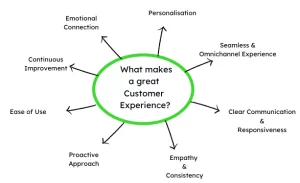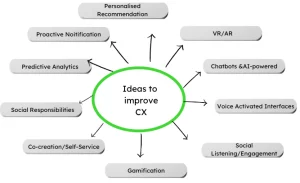Understanding Customer Experience (CX)-How to Create a Great One?
You just launched a new website for your skin care product business. And just after the launch you observed 20% higher sales than expected. But why does this happen? It is because of good customer experience.
After analysing the website’s performance and taking feedback from the customers, you could find the easy navigation, one-click purchase helped, SEO optimisation, and easy to browse website layout contributed to attracting buyers. And this led to higher sales for you.
Based on the interaction on the website, if a customer happens to stay longer on your website, it can be because of a good customer experience.
If you are struggling to gain higher visibility of your website which can further attract customers, you must understand the dynamics of customer experience.
What is Customer Experience?
CX meaning or Customer experience refers to the overall impression and perception of a brand or company based on their interactions and satisfaction throughout their journey. It encompasses all touchpoints and interactions, shaping their feelings, loyalty, and advocacy.

- Customer experience refers to customer interactions and engagements with a brand throughout its journey, from initial awareness to post-purchase support.
- It encompasses all touchpoints and channels, including online and offline interactions, such as website visits, social media engagement, customer service interactions, product usage, and more.
- A positive customer experience is characterised by seamless, personalised, and meaningful interactions that meet or exceed customer expectations. It involves understanding and anticipating customer needs, providing relevant and valuable information, and delivering exceptional service at every step. This includes user-friendly interfaces, clear communication, prompt response times, knowledgeable support staff, and efficient issue resolution.
- Customer experience management involves designing and orchestrating all touchpoints to create a cohesive and enjoyable customer journey. It requires aligning the organisation’s processes, systems, and people to ensure consistency and effectiveness across different channels and departments.
- This holistic approach enables businesses to cultivate strong customer relationships, foster loyalty, and drive customer satisfaction, increasing customer retention, positive word-of-mouth referrals, and sustainable business growth.
- Customer experience goes beyond individual transactions or isolated interactions. It considers the customer’s overall perception of the brand, influenced by factors such as brand reputation, values, and alignment with the customer’s values. Emotional connections, brand consistency, and authenticity also significantly shape the customer experience.
- Measuring customer experience involves collecting and analysing feedback, customer satisfaction surveys, Net Promoter Scores (NPS), and other metrics to assess customer sentiment and identify areas for improvement.
By continuously monitoring and optimising the customer experience, organisations can stay agile, responsive, and customer-centric, fostering long-term loyalty and advocacy while gaining a competitive edge in the market.
Also Read: UX and CX: What’s the Difference?
What Makes a Great Customer Experience?
Ever since the rise of competition in brands, what actually mattered is customer experience.
CX full form is customer experience which implies that a happy customer can not only make a repeat purchase but can also bring in referral customers. And thus ultimately brings for you business growth.
Several key elements characterise an excellent CX:

Personalization:
Tailoring interactions and offerings to individual customer preferences and needs. This includes personalised recommendations, targeted marketing, and customised experiences that make customers feel valued and understood.
Seamless and Omnichannel Experience:
Providing a consistent and seamless experience across various channels and touchpoints. Customers should be able to transition effortlessly between online and offline interactions, with their information and preferences seamlessly synchronised.
Clear Communication:
Effective and transparent communication is essential for a great customer experience. Timely updates, clear instructions, and proactive notifications about product/service changes or issues help build trust and reduce customer frustration.
Responsiveness:
Prompt and attentive responses to customer inquiries, concerns, or issues. Whether through live chat, phone, email, or social media, customers expect timely and helpful support that resolves their problems efficiently.
Empathy and Understanding:
Demonstrating genuine care and empathy towards customers’ challenges and concerns. Customer service representatives who actively listen, show understanding, and provide empathetic support contribute to a positive experience.
Consistency:
Consistency across all touchpoints and interactions is crucial. Customers should receive the same level of service, quality, and attention regardless of the channel or department they interact with. Consistency builds trust and reliability.
Proactive Approach:
Anticipating customer needs and taking proactive measures to address them. This includes providing relevant information, anticipating potential issues, and offering solutions before customers ask.
Ease of Use:
Simplifying processes, user interfaces, and customer journeys. Making it easy for customers to find information, navigate through platforms, and complete transactions enhance their satisfaction and reduce frustration.
Continuous Improvement:
Seeking feedback, analysing data, and actively striving to improve the experience. Regularly evaluating customer feedback, identifying pain points, and implementing enhancements ensure that the experience evolves and remains relevant.
Emotional Connection:
Building an emotional connection with customers by aligning with their values, creating memorable experiences, and fostering a sense of belonging. Emotional connections make loyal customers who become advocates for the brand.
Innovative Ideas To Improve Customer Experience
Improving customer’s experience is essential for fostering customer loyalty, driving repeat business, and gaining a competitive edge in the market.

Here are some innovative ideas to improve the experience:
Personalised Recommendations:
Leverage artificial intelligence and machine learning algorithms to provide personalised product recommendations based on customer preferences, past purchases, and browsing history. This can help customers discover relevant products and enhance their shopping experience.
Virtual Reality (VR) and Augmented Reality (AR):
Integrate VR and AR technologies to offer immersive experiences to customers. For example, allowing customers to virtually try on clothing or visualise how furniture would look in their space. This enhances engagement and confidence in purchasing decisions.
Chatbots and AI-Powered Assistants:
Implement intelligent chatbots and virtual assistants to respond instantly and accurately to customer queries. These automated systems can handle common inquiries, freeing human agents to focus on more complex or sensitive customer interactions.
Voice-Activated Interfaces:
Incorporate voice-activated interfaces, such as voice assistants or voice-controlled navigation, to simplify customer interactions. Voice commands can be used for tasks like searching for products, placing orders, or accessing support, enhancing convenience and speed.
Seamless Omni-Channel Integration:
Ensure seamless integration across multiple channels, such as websites, mobile app, social media, and physical stores. Customers should be able to start an interaction on one channel and seamlessly continue on another, with their information and context preserved.
Social Listening and Engagement:
Monitor social media platforms to listen to customer feedback, concerns, and conversations about your brand. Engage in proactive and meaningful interactions to address issues, provide support, and build relationships with customers.
Gamification:
Introduce gamification elements to make the user’s experience more interactive and enjoyable. Reward customers for completing specific actions, offer loyalty points or create challenges that encourage engagement and build excitement.
Proactive Notifications:
Utilise automated notifications to keep customers informed about order updates, delivery status, and personalised recommendations. Proactively notify customers of relevant promotions, new product launches, or upcoming events based on their preferences.
Self-Service Options:
Develop intuitive self-service platforms where customers can easily find answers to common questions, access tutorials or guides, and resolve issues independently. This empowers customers and provides them with quick solutions.
Co-Creation and Feedback:
Involve customers in product development by soliciting feedback, conducting surveys, or even inviting them to beta testing. This makes customers feel valued and helps create products and services that better meet their needs.
Social Responsibility Initiatives:
Align your brand with social responsibility initiatives that resonate with your target audience. Communicate your commitment to sustainability, ethical practices, or community involvement, demonstrating shared values and enhancing customer trust.
Predictive Analytics:
Utilise predictive analytics to anticipate customer needs and preferences. By analysing historical data, you can offer personalised recommendations, suggest complementary products, or even proactively address potential issues before they arise.
Implementing these innovative ideas can differentiate your brand and create memorable experiences that drive loyalty, satisfaction, and advocacy.
It is important for a brand to continually explore new technologies, listen to customer feedback, and adapt your strategies to evolving customer expectations. Improving customer experience is essential for fostering customer loyalty, driving repeat business, and gaining a competitive edge in the market.
Brand Example that Improve Customer Experience for Higher ROI
Amazon’s relentless focus on customer-centricity, seamless online shopping experiences, fast and reliable delivery, personalised product recommendations, and easy returns have contributed to its exceptional customer experience. By continuously improving customer experience, Amazon has cultivated customer loyalty, gained repeat business, and achieved significant financial success.

Here are some key ways Amazon has improved the customer experience:
- Broad Product Selection: Amazon offers various products across various categories, ensuring customers can find almost anything they want in one place.
- User-Friendly Website and Mobile App: Amazon provides a seamless and intuitive interface for easy navigation, product search, and purchase, ensuring a smooth shopping experience.
- Personalised Recommendations: Amazon leverages customer data to offer personalised product recommendations based on browsing and purchase history, enhancing the relevance of product suggestions.
- Fast and Reliable Delivery: Amazon has established a robust logistics network and introduced services like Amazon Prime for expedited shipping, ensuring prompt and reliable delivery of orders.
- Efficient Returns and Refunds: Amazon has simplified the return process, providing hassle-free returns and refunds, which instils confidence in customers and encourages them to make purchases.
- Customer Reviews and Ratings: Amazon incorporates customer reviews and ratings for products, helping shoppers make informed purchase decisions and fostering trust in the quality of products.
- Customer Support: Amazon offers responsive and accessible customer support through various channels, including phone, email, and live chat, ensuring prompt assistance and issue resolution.
- Subscription Services: Amazon offers subscription-based services like Amazon Prime, providing benefits such as free shipping, streaming services, and exclusive deals, creating added value for customers.
- Continuous Innovation: Amazon consistently invests in new technologies and features to enhance the customer experience, such as voice-activated ordering through Amazon Echo and the introduction of cashier-less Amazon Go stores.
- Community Engagement: Amazon engages with customers through features like customer forums, Q&A sections, and seller feedback, fostering a sense of community and facilitating customer interactions.
- Prime Day and Promotions: Amazon hosts annual events like Prime Day, offering exclusive deals and discounts, creating excitement and incentivizing customers to shop on specific occasions.
Conclusion
Customer experience is a customer’s overall impression of a brand, shaped by their interactions and satisfaction throughout their journey. It encompasses every touchpoint, from initial awareness to post-purchase support.
A positive customer experience is crucial for fostering loyalty and advocacy. If you want to enhance your website design and create a seamless customer experience, consider partnering with Noboru.
Our expertise in website design can help elevate your brand and optimise user experiences. Contact us today at hello[at]noboruworld.com for a consultation.
FAQ
What is customer experience?
Customer experience refers to a brand’s overall perception and impression based on their interactions throughout their journey.
Why is customer experience important?
Customer experience is important because it influences customer satisfaction, loyalty, and advocacy, ultimately impacting a business’s success and profitability.
What factors contribute to a great customer experience?
Personalization, seamless interactions, clear communication, responsiveness, empathy, consistency, and proactive approaches contribute to a great customer experience.
How can businesses improve customer experience?
Businesses can improve customer experience by focusing on personalization, seamless omnichannel integration, clear communication, responsiveness, and continuously seeking feedback for improvement.
How is customer experience measured?
Customer experience can be measured through various methods, including customer satisfaction surveys, Net Promoter Scores (NPS), feedback analysis, and monitoring social media sentiment.
What are the benefits of a positive customer experience?
A positive customer experience leads to increased customer loyalty, repeat business, positive word-of-mouth referrals, improved brand reputation, and long-term business growth.
Also Read – 10 Ways to Boost Customer Satisfaction



